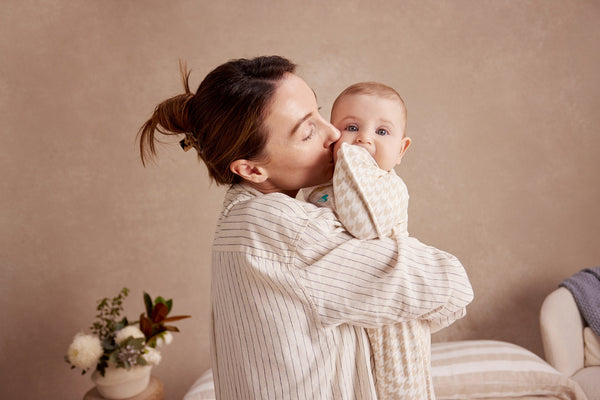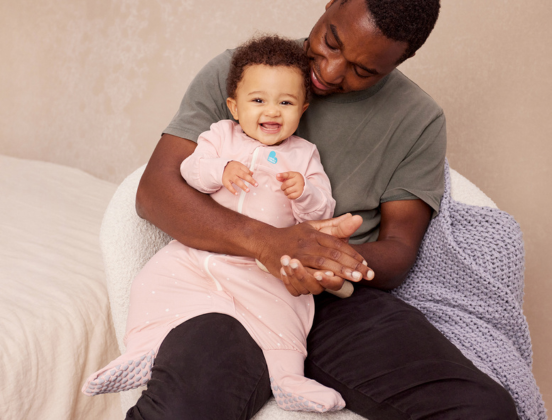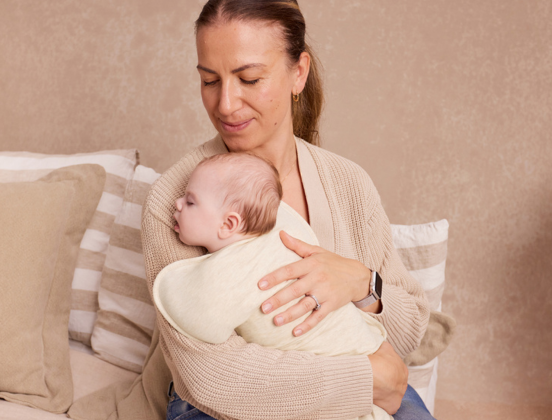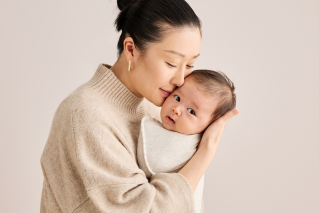Older children often self-soothe using the below methods:
- Looking, listening, or touching preferred stimuli (toys, blanket, pacifier etc.)
- Movement.
At what age do babies learn to self-settle?
From birth to three months old, most children need physical or emotional assistance from a parent/caregiver to fall back to sleep. Rocking, feeding, holding, or offering a pacifier are common ways to achieve this.
At between four to five months old, you will start to notice a change in your child’s sleep patterns. At this stage of development, a child’s circadian rhythm and sleep cycles are maturing. This is a great opportunity to introduce self-settling techniques, particularly before the four-month sleep regression phase.
How to encourage self-settling
It’s important to create a safe sleeping environment, bedtime routine, and avoid overtiredness when trying to encourage self-settling.
From timings to safe sleep methods, follow the below steps to ensure your child has the best chance of learning how to self-settle.
Master the timing
On average, children will begin to demonstrate self-soothing behaviours between three to four months old. By this time, their sleep cycles have begun to mature, and they may not be able to fall back to sleep between REM and non-REM stages.
By six months, most infants can sleep for approximately eight hours without needing to feed. Helping your child learn how to self-soothe before separation anxiety kicks in (usually around eight-nine months) will enable them to have a better chance of a good night’s sleep.
Create a safe sleeping environment
Always follow the below steps to ensure your baby has a safe sleeping environment.
- First Candle suggest the safest place for a baby to sleep is on a separate sleep surface designed for infants close to the parents bed. Ideally for at least the first 6 months.
- Always remove toys, blankets, and other choking hazards from the baby’s bassinet/crib before sleep.
- Keep the crib/bassinet away from hanging cords such as blinds, curtains, and electrical appliances.
- Always put your child to sleep on their back with the face uncovered.
- Ensure the mattress is clean, flat, dry, and the correct size for the crib.
- Never use electric blankets, hot water bottles or wheat bags.
- Never co-sleep with your child.
Establish a bedtime routine
A calming routine will help your little one to recognise that it’s time to sleep. Close the curtains/blinds, speak in hushed tones, and try to stick to the same bedtime each night.
Your bedtime routine might look like a bath, reading a book, singing a lullaby, baby massage, or white noise. Find what works for you and your family.
Choose a bedtime (and stick to it)
It’s important to stick to a set bedtime each night to help your child recognise when it’s time to sleep. Keep the room dark or dimly lit, stay calm and quiet when your baby wakes, and avoid playtime in the evening.
Avoid overtiredness
An overtired child will struggle to regulate their emotions and will find it difficult to fall asleep. Below, find common signs your little one is overtired.
- Yawning.
- Crying or fussing.
- Arching their back.
- Frowning.
- Difficult to soothe.
- Catnapping often.
- Falling asleep at unusual times i.e., before feeding.
Self-settling techniques for babies
Once you have created a safe sleeping environment, established a routine, and decided on a bedtime, you can begin to introduce self-settling techniques. Find what works for you and your family.
Common settling techniques
Try to establish a bedtime routine that your baby responds well to. Common settling techniques include the ‘pick-up, put-down settling method’ and the ‘shush-pat settling method’.
Try our Swaddle Up™
Our award-winning SWADDLE UP™ is designed to encourage your little one to safely self-soothe. Its unique wing tips mean your child can sleep in a more natural ARMS-UP™ position while the twin zipper enables easy nappy changes without disturbing sleep.
Once your child start to show signs of rolling over or pulling up onto their hands, you must stop swaddling. Designed to help your little one slowly graduate to arms-free sleep, our Ready To Roll collection features Transition Suits and Bags™ with wings that can be removed one by one.
Keep your child in their crib when they wake
If your baby wakes up in the middle of the night and is struggling to self-soothe, try to avoid taking them out of their crib/bassinet. Instead, quietly comfort them with gentle words, singing, or light pats whilst they remain in their crib/bassinet. In time, this will hopefully encourage them to self-soothe.





















